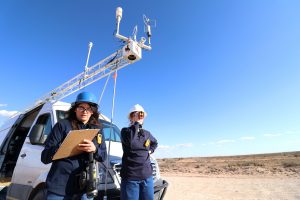 Last year, EDF announced a first-of-its-kind project to measure and map emissions from the Permian Basin — the nation’s most productive oilfield and the primary source of New Mexico’s methane problem.
Last year, EDF announced a first-of-its-kind project to measure and map emissions from the Permian Basin — the nation’s most productive oilfield and the primary source of New Mexico’s methane problem.
Although the Permian Basin has led the world in oil and gas production, public data on its emissions has been near nonexistent. PermianMAP is changing that, and we’ve launched the project’s first tranche of data to help regulators, companies and the public understand and address the region’s methane challenge.
The scale of emissions PermianMAP uncovered is sobering, but this publicly available data will prove critical as New Mexico advances nation-leading rules under Gov. Lujan Grisham to cut methane pollution and achieve the state’s climate and clean air goals.
New Mexicans need methane action, now more than ever
The methane leak rate we observed in the Permian is roughly three times EPA’s national average, and total annual emissions from the Permian are over 1.4 million metric tons. That’s enough wasted gas to meet the needs of every home in New Mexico for the next two years.
Despite economic headwinds and turbulent oil markets, the need for methane action is more present than ever. Just last week the International Energy Agency reported that despite the current downturn, methane emissions risk rising as operators cut staffing and potentially allow leaks to go unnoticed or unfixed.
Groundbreaking data is a wake-up call in the Permian, call to action for New Mexico Share on XMeanwhile, the Trump administration continues its efforts to roll back federal methane standards while industry trade groups waste no time pushing to undercut climate and clean air policies put in place to protect Americans. Environmental standards that protect communities should never be contingent on commodity prices.
What’s more, efforts to mitigate methane remain economic even at today’s depressed oil prices, with the IEA finding that one third of emissions could be cut at no net cost to the industry.
Emission cuts are critical for public health and resilience
During the current public health crisis, Gov. Lujan Grisham has been a national leader thanks to her decisive action to protect the wellbeing of New Mexicans by following sound science and medical advice.
She has exhibited the same leadership on tackling the state’s oil and gas pollution problems and protecting the state’s most vulnerable. Over 75% of children under 5 years old in Eddy, Lea and San Juan counties live within a mile of an active oil and gas site. New Mexico needs comprehensive safeguards in place to protect them from co-pollutants emitted alongside methane, which include toxics like benzene, toluene and smog-forming volatile organic compounds.
Strong oil and gas pollution safeguards would also help address the fact that methane emissions cost New Mexico’s taxpayers over $43 million in lost revenue every year. At a time when those resources are needed to support priorities like public health and education, there’s no excuse for this continued and avoidable waste.
Public data can drive innovation and accelerate progress
Methane represents a long-term challenge for regulators and companies, and having the data to track and pinpoint the problem is critical for solving it.
The state of New Mexico is already working with Descartes Labs to build a “data refinery” to leverage existing data and help regulators target emissions from the Permian Basin. EDF’s PermianMAP offers a valuable resource for efforts like these, and for informing state agencies as they work toward the governor’s commitment to nation-leading methane rules.
Similarly, PermianMAP is intended to help oil and gas operators confront their methane challenge by equipping them with the data needed to better understand and manage their emissions. How companies respond now, while dealing with the current crisis, will be key to how they’ll be perceived by investors and the public in the continued transition to a low-carbon economy.
PermianMAP’s initial findings underscore the distance many Permian operators have to go. The dramatic emissions rate is also a reminder that years of lax oversight and failure to address emissions are what’s allowed this problem to swell.
However, progress is on the horizon and this project has the potential to help accelerate the work already under way by the Lujan Grisham administration. As we look ahead to a recovery, reducing these emissions is a vital opportunity for regulators and companies to show the world they’re serious about meeting the cleaner energy challenge.









